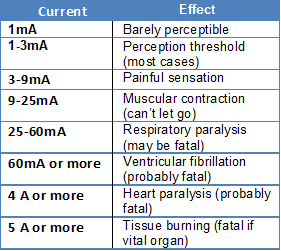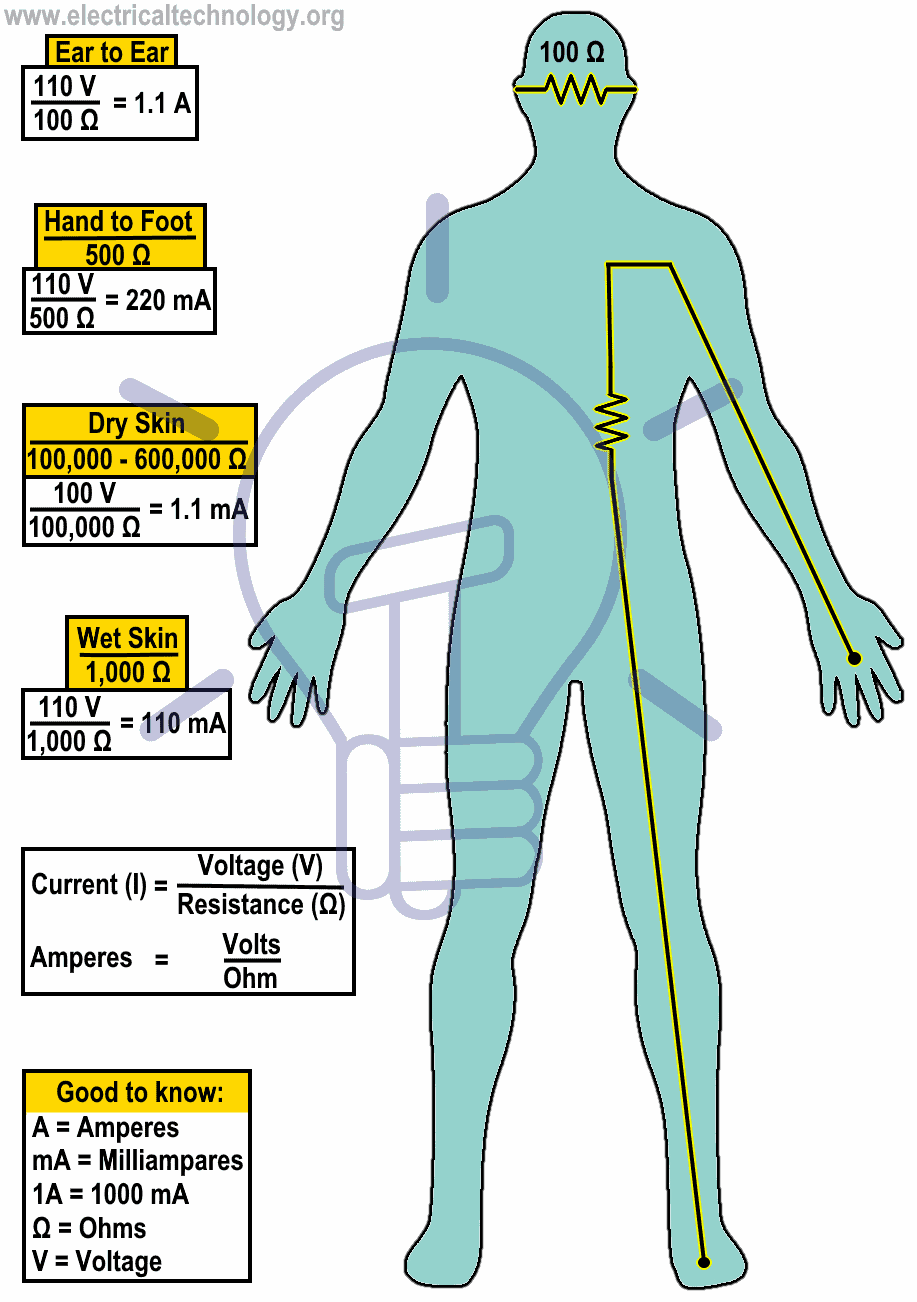Electrical Shock Hazards & Its Effects on Human Body
Electrical Shock Hazards & Effects
What is Electrical Hazard?
Electrical hazard or Electric Shock may be defined as “Dangerous event or condition due to direct or indirect electrical contact with energized conductor or equipment and from which a person may sustain electrical injury from shock, damage to workplace environment, damage to property or both.
When working with or nearby electrical installations an electrical shock, arc flash or arc blast can occur and a current can go through the body, due to the following situations:
- Direct contact with live parts of the installation (exposure to live parts)
- Contact with parts that normally are not live, but as a consequence of a fault become live accidentally (indirect contact)
- Existence of potential difference between different points in the ground
Related Post:
- Protective Actions to Avoid & to Reduce Electric Hazardous
- Personal Protective Equipment (PPE) for Electrical Works
The effects of electrical current through the human body vary according to:
- The voltage
- The time the current flows
- The value of the current
- The frequency of the network
- The pathway of the current
- The ability of the person to react
Electrical installations with voltages up to 50 V, in dry places, and up to 25V, in wet or humid places (AC) and up to 120 V in DC are considered safe in what concerns direct and indirect contacts.
The duration of the fault must be limited by the action of protection relays and devices. Below is a given table which shows the different values of current and its effect on human body. Keep in mind that it is the average value and not meant to be same for everyone as it depends on different factors.

Increase of frequency decreases the danger of current through the human body. The called “industrial frequencies” (50 Hz or 60 Hz) are the more dangerous.
Related post: Emergency Planning for Safety & Protection in Industries & Installations
AC or DC, Which one is dangerous ?
Keep in mind that both the AC and DC voltages and Currents are dangerous & hazardous. But AC with 50 or 60Hz frequency is more dangerous than the same voltage of level for DC. For more info, read the previous post about AC or DC – Which One is More Dangerous And Why ?

The value of the current through the body depends of the resistance of the skin. This resistance depends of several factors such as:
- Humid or wet skin
- Thickness of the skin at the contact point
- Psychological condition
- Weight
- Sex
- Age
The pathway of the current through the human body is unpredictable, and pathways through the heart are the most dangerous. Figure 1 shows possible pathways.
Figure 1 – Pathways of current
When an electrical current flows through the physiological tissues there is an interference with the electrical processes of the human body, namely with nerves, muscles and the heart.
The tissues are also subjected to heating and electrochemical reactions that provoke the deterioration of the tissues.
The hazardous of electrical shock are the following:
- Loose of motion control
- Respiratory arrest
- Pain
- Physical fatigue
- Ventricular fibrillation
- Cardiac arrest
- Burns
Click image to enlarge

Some of these injuries can cause death, namely respiratory arrest, ventricular fibrillation, cardiac arrest and burns.
Loose of motion control can cause pain and secondary injuries due to falls.

Ventricular fibrillation is due to the uncontrolled contractions of the heart fibers, that can provoke a cardiac arrest and the lack of brain irrigation, and it is one of the main causes of death due to electrical shock.
Electrical burns are the consequences of Joule effect, and taking into account the injuries they provoke, they are classified in 3 degrees – 1, 2 and 3, being this one the most dangerous and that can cause dead.
Note: Its must to use PPE when working on live and energized equipment for safety and protection
Good to Know:
- The average resistance of a human body in dry condition is almost ≈ 100,000Ω while the resistance of a human body in wet condition is 1000Ω.
- Also, the voltage above 50V (in dry condition) and 25V (in wet condition) is enough to shock a person. Also, 30 mA (RCDs are set in the UK) is enough for respiratory paralysis while 75-100 mA will cause ventricular fibrillation (rapid & ineffective heartbeat).
- Anything higher than 300mA is fatal and kills in seconds. 4.5 to 10A will instantly lead to cardiac arrest, severe burns and finally death.
- Overall, it is mainly the eclectic power (a mixture of current and voltage) where voltage (as a pressure) pushes electric current (as a flow of charge) is responsible for electric shock.
[/box]
Related Posts:
- Which One is More Dangerous? 120V or 230V and Why?
- Which One Kills – Current or Voltage and Why? Amps vs Volts
- Which One is More Dangerous? 50Hz or 60Hz in 120V/230V & Why?
- AC or DC – Which One is More Dangerous And Why ?
- Is Lightning AC or DC ?
- Difference between AC and DC (Current Voltage)
- Why Can’t We Store AC in Batteries instead of DC?
- Why Can’t a 12V Car Battery Electrocute You?
- What Happens if a Battery is Connected to the AC Supply?
- Why Do Electronic Circuits Use DC Current instead of AC?
- What Happens When an AC Line Touches a DC Line?
- Why Don’t Birds and Squirrels Get Electrocuted on Power Lines?
- Transformers Fire Protection System Causes, Types & Requirements
- Difference Between Grounding, Earthing and Bonding
- Electrical Earthing – Methods and Types of Earthing & Grounding








How would you do this to a human on purpose?
Is it possible for someone to put an object in your body then send shocks thru your body with a phone or computer if a chip nor some sort is placed inbody ears or eyes
Hwo come we don’t die when we get shocked from an outlet? If there’s no device doing work, and we get shocked, shouldn’t we instantly die? In my case, voltage is 120 and amps are around 10 to 30, depending on the breaker.
I’m being shocked on my stomach and various parts of my body and not directly connected to anything what type of shock could it be